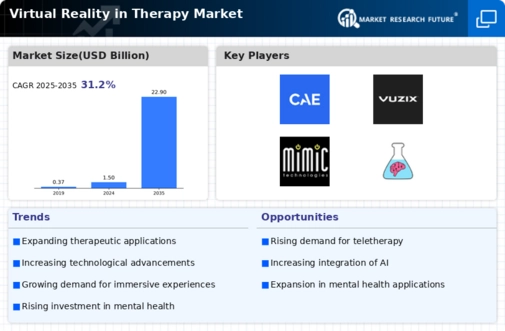Top Industry Leaders in the Virtual Reality Therapy Market
Latest Company Updates:
The Health Economics and Outcomes Research (HEOR) service for clinical trials was introduced by virtual contract research organisation (VCRO) Curavit Clinical Research in 2023. According to Curavit, the use of HEOR in clinical trials will provide pharmaceutical companies with information about the prospective market and worth of their products. According to Curavit, the services will pay particular attention to the health economics value of digital medicines, which will be evaluated by the business for both individual patients and health populations. Clinical studies will employ HEOR, which will be evaluated upon study closure to determine the digital therapeutic's financial effect.
By 2023, With its 150-year history and a concentration on three verticals: medicines, consumer health, and crops, Bayer is one of the oldest healthcare organisations in the world with its headquarters located in Leverkusen, Germany.
HTC is launching into space in 2023. The firm today announced that a modified, microgravity friendly Vive Focus 3 VR headset would be transported to the International Space Station as part of a scheduled NASA resupply mission on November 7.
Some of Virtual Reality in Therapy Companies Listed Below:
- Siemens Healthcare (Germany)
- Virtalis Ltd (U.K.)
- CAE Healthcare (U.S.)
- GE Healthcare (U.S.)
- Virtual Realities Llc (U.K.)
- Qualcomm Technologies Inc. (U.S.)
- Samsung Group (South Korea)
- Vuzix (U.S.)
- Mimic Technologies Inc (U.S.)
- Brainlab (Germany)
Strategies Fueling Growth:
- Immersive Exposure Therapy: VR allows for creating safe and controlled environments to confront phobias, anxieties, and trauma, enabling exposure therapy in a realistic and engaging way.
- Pain Management and Distraction: VR can divert attention from physical pain, providing relief and improving treatment outcomes for chronic pain conditions.
- Neurocognitive Rehabilitation: VR simulations can challenge and retrain cognitive functions, aiding in rehabilitation after injury or neurological disorders.
- Improved Accessibility and Affordability: Development of mobile VR and affordable headsets expands access to VR therapy, particularly for geographically isolated or cost-conscious populations.
Market Share Decoding: Key Factors to Consider
- Clinical Efficacy and Validation: Rigorous clinical research and evidence-based protocols are crucial for building trust and wider adoption in the medical field.
- Content Quality and Diversity: Availability of high-quality, engaging, and clinically-appropriate VR content for various therapeutic areas drives market differentiation.
- Ease of Use and Integration: User-friendly interfaces and seamless integration with existing healthcare workflows are essential for therapist and patient acceptance.
- Data Privacy and Security: Robust data security measures and transparent privacy policies are paramount for handling sensitive patient information in VR environments.
New and Emerging Stars: Lighting the Path:
- Biofeedback Integration: Startups like NeuroSync and Neurable are incorporating biofeedback sensors into VR experiences, allowing real-time data collection and personalized therapy adjustments.
- Multimodal VR Therapy: Companies like XRHealth and Virta Health are blending VR with other therapeutic modalities like mindfulness and cognitive behavioral therapy for enhanced treatment efficacy.
- Telehealth Applications: Platforms like VR2GO and Healium are exploring VR-powered telehealth solutions, making therapy more accessible and convenient for geographically dispersed patients.
Investment Trends: Where the Capital Flows:
- Content Development and Studios: Investments are pouring into building studios and platforms for creating high-quality and clinically-validated VR therapy content.
- VR Hardware and Technology: Development of lighter, more comfortable, and affordable VR headsets is attracting significant investment to expand market reach.
- Artificial Intelligence and Personalization: Integration of AI into VR therapy for personalized experiences and adaptive treatment protocols is seeing major investment.
- Research and Development: Partnerships between VR companies, research institutions, and healthcare providers are fueling investments in clinical research and validation of VR therapy modalities.









